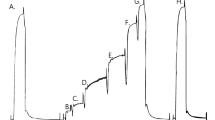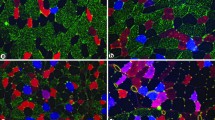Summary
In multinucleated skeletal muscle fibres the size of the cytoplasmic volume-to-myonucleus ratio is related to the myosin heavy chain phenotype, with the ratio being larger in those fibres expressing the fast myosin heavy chain phenotype. It is unknown, however, whether this ratio is modulated during muscle fibre adaptation, such as that which occurs following muscle unloading. In this study the relationship between cross sectional area, myonuclear number and myosin type, in single fibres from the plantaris and soleus muscles of adult rats following 28 days of hindlimb suspension was examined. Each fibre was cut transversely into two segments; one segment was used for immunohistochemical identification of myosin type, the other for determination of cross sectional area and myonuclei number. Single fibre analysis revealed significant atrophy of both plantaris fast and soleus slow fibres; the mean cross sectional area (μm2) of these fibres, 3104±183 and 2082±107 (mean ±se), being 70 and 45%, respectively, of control means. The decreases in cross sectional area were not accompained by corresponding decreases in the number of myonuclei (myonuclei/mm); in plantaris fast fibres the mean myonuclei counts were within the control range (88±8 (hindlimb suspension), 76±7 (control)), in soleus slow fibres the counts were significantly increased (185±12 (hindlimb suspension), 154±11 (control)). The changes resulted in a significant decrease in the cytoplasmic volume-to-myonucleus ratio (μm3×103) for both fibre types; the mean ratios of 39±3 and 12±1, were 60% and 36% of control means for the plantaris fast and soleus slow fibres, respectively. These results indicate that following hindlimb suspension atrophy of muscle fibres the myonuclei numbers remain constant or increase and, hence, the effective cytoplasmic-to-myonucleus ratio is decreased. Further, the described changes are significantly greater in soleus slow than plantaris fast fibres.
Similar content being viewed by others
References
ALOISI, M., MUSSINI, I. & SCHIAFFINO, S. (1971). Activation of muscle nuclei in denervation and hypertrophy. In Basic Research in Myology, Part 1 (edited by B. A.KAKULAS) pp. 338–45. Amsterdam: Excerpta Media.
BABIJ, P. & BOOTH, F. W. (1988) Alpha-actin and cytochrome c mRNAs in atrophied adult rat skeletal muscle. Am. J. Physiol. 254, C651–6.
BAKER, J. H. & MATSUMOTO, D. E. (1988) Adaptation of skeletal muscle to immobilization in a shortened position. Muscle Nerve 2, 231–244.
BLAU, H. (1992) Differentiation requires continuous active control. Annu. Rev. Biochem. 61, 1213–30.
COHEN, J. (1988) Statistical power analysis of the behavioral sciences. Hillsdale, NJ: Erlbaum Associates.
DARR, K. C. & SCHULTZ, E. (1989) Hindlimb suspension suppresses muscle growth and satellite cell proliferation. J. Appl. Physiol. 67, 1827–34.
DESPLANCHES, D., KAYAR, S. R., SEMPORE, B., FLANDROIS, R. & HOPPELER, H. (1990) Rat soleus muscle ultrastructure after hindlimb suspension. J. Appl. Physiol. 69, 504–8.
EDGERTON, V. R. & ROY, R. R. (1991) Regulation of skeletal muscle fibre size, shape and function. J. Biomech. 24, 123–33.
ESSER, K. A. & HARDEMAN, E. C. (1995) Changes in contractile protein mRNA accumulation in response to spaceflight. Am. J. Physiol. 268, C466–71.
FITTS, R. H. & MCDONALD, K. S. (1993) Effect of hindlimb unweighting on single soleus fiber maximal shortening velocity and ATPase activity. J. Appl. Physiol. 72, 2949–57.
GIBSON, M. C. & SCHULTZ, E. (1982) The distribution of satellite cells and their relationship to specific fibre types in soleus and extensor digitorum longus muscles. Anat. Rec. 202, 329–37.
HALL, Z. W. & RALSTON, E. (1989) Nuclear domains in muscle cells. Cell 59, 771–2.
HAUSCHKA, E. O., ROY, R. R. & EDGERTON, V. R. (1987) Size and metabolic properties of single muscle fibres in rat soleus after hindlimb suspension. J. Appl. Physiol. 62, 2338–47.
HERBERT, R. D. & BALNAVE, R. J. (1993) The effect of position of immobilisation on resting length, resting stiffness, and weight of the soleus muscle of the rabbit. J. Ortho. Res. 11, 358–66.
JASPERS, S. R. & TISCHLER, M. E. (1984) Atrophy and growth failure of rat hindlimb muscles in tail-cast suspension. J. Appl. Physiol. 57, 1472–9.
KANDARIAN, S. C., BOUSHEL, R. C. & SCHULTE, L. M. (1991) Elevated interstitial fluid volume in rat soleus muscles by hindlimb unweighting. J. Appl. Physiol. 71, 910–14.
KASPER, C. E. (1995) Sarcolemmal diruption in reloaded atrophic skeletal muscle. J. Appl. Physiol. 79, 607–14.
KASPER, C. E., MCNULTY, A. L., OTTO, A. J. & THOMAS, D. P. (1993) Alterations in skeletal muscle related to impaired physical mobility: an empirical model. Res. Nursing Health 16, 265–73.
MILLER, J. B., CROW, M. T. & STOCKDALE, F. E. (1985) Slow and fast myosin heavy chain content defines three types of myotubes in early muscle cell cultures. J. Cell Biol. 101, 1643–50.
ONTELL, M. (1974) Muscle satellite cells: a validated technique for light microscopic identification and a quantitative study of changes in their population following denervation. Anat. Rec. 178, 211–28.
PAVLATH, G. K., RICH, K., WEBSTER, S. G. & BLAU, H. M. (1989) Localization of muscle gene products in nuclear domains. Nature 337, 570–3.
PETTE, D. & DUSTERHOFT, S. (1992) Altered gene expression in fast-twitch muscle induced by chronic low-frequency stimulation. Am. J. Physiol. 262, R333–8.
ROTUNDO, R. L. & GOMEZ, A. M. (1990) Nucleus-specific translation and assembly of acetylcholinesterase in multinucleated muscle cells. J. Cell Biol. 110, 715–19.
ROY, R. R., BELLO, M. A., BOUISSOU, P. & EDGERTON, V. R. (1987) Size and metabolic properties of fibres in rat fast-twitch muscles after hindlimb suspension. J. Appl. Physiol. 62, 2348–57.
SCHMALBRUCH, H. & LEWIS, D. M. (1994) A comparison of the morphology of denervated with aneurally regenerated soleus muscle of rat. J. Muscle. Res. Cell Motil. 15, 256–66.
SCHULTZ, E. (1985) Satellite cells in normal, regenerating and dystrophic muscle. In Gene Expression in Muscle (edited by STROHMAN & WOLF) pp. 73–84.
SCHULTZ, E., JARYSZAK, D. L. & VALLIERE, C. R. (1985) Response of satellite cells to focal skeletal muscle injury. Muscle Nerve 8, 217–22.
SNOW, M. H. (1981) Satellite cell distribution within the soleus muscle of the adult mouse. Anat. Rec. 201, 463–9.
STEFFEN, J. M. & MUSACCHIA, X. J. (1984) Effect of hypokinesia and hypodynamia on protein, RNA and DNA in rat hindlimb muscles. Am. J. Physiol. 247, R728–32.
TISCHLER, M. E., HENRIKSEN, E. J., MUNOZ, K. A., STUMP, C. S., WOODMAN, C. R. & KIRBY, C. R. (1993) Spaceflight on STS-48 and earth-based unweighting produce similar effects on skeletal muscle of young rats. J. Appl. Physiol. 74, 2161–5.
TOWNSEND, K. M. S., STRETCH, A., STEVENS, D. L. & GOODHEAD, D. T. (1990) Thickness measurements on V79–4 cells: a comparison between laser scanning confocal microscopy and electron microscopy. Int. J. Radiat. Biol. 58, 499–508.
TSENG, B. S., KASPER, C. E. & EDGERTON, V. R. (1994) Cytoplasm-to-myonucleus ratios and succinate dehydrogenase activities in adult rat slow and fast muscle fibres. Cell Tissue Res. 275, 39–49.
Author information
Authors and Affiliations
Rights and permissions
About this article
Cite this article
Kasper, C.E., Xun, L. Cytoplasm-to-myonucleus ratios in plantaris and soleus muscle fibres following hindlimb suspension. J Muscle Res Cell Motil 17, 603–610 (1996). https://doi.org/10.1007/BF00124358
Received:
Revised:
Accepted:
Issue Date:
DOI: https://doi.org/10.1007/BF00124358




